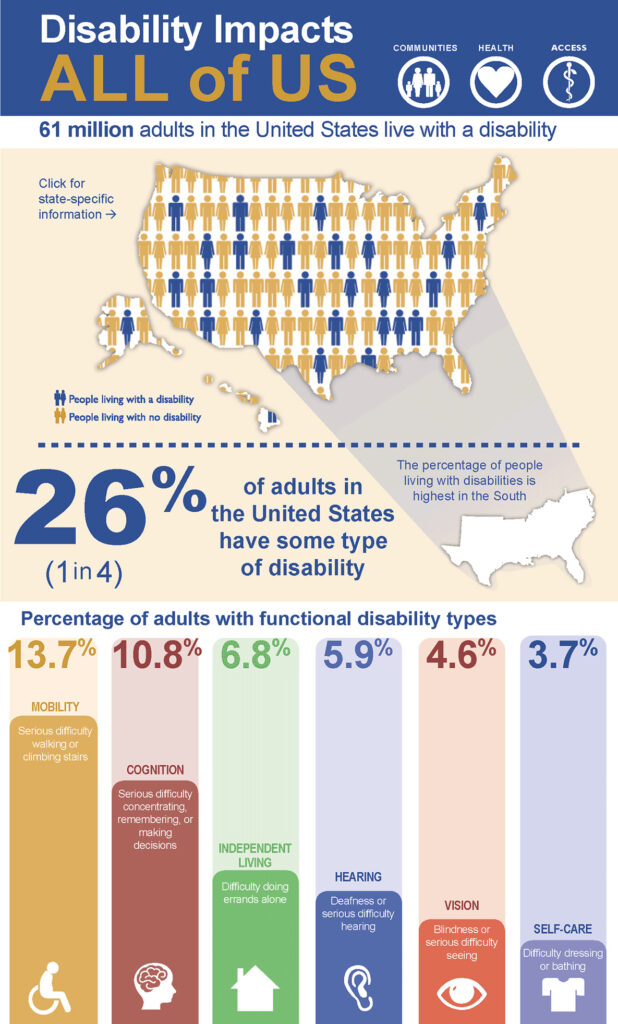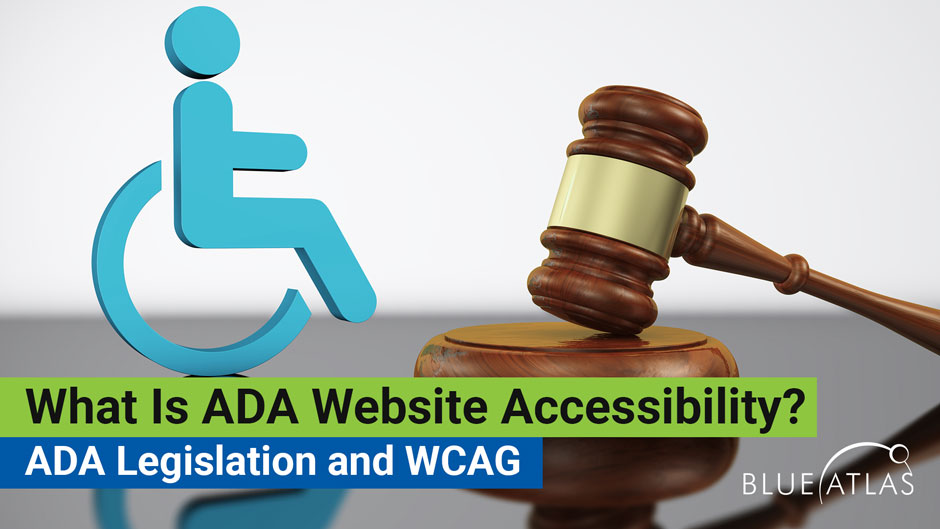How Many People with Disabilities in the US?

When first considering website accessibility, many businesses have similar questions: “How important is this? How many disabled people would visit our site? Are we losing business by not including accessibility upgrades?”
Businesses really can lose customers if their sites do not meet accessibility requirements. They can also get into legal trouble, as court decisions have indicated that the ADA (American with Disabilities Act) also applies to business websites, especially those that facilitate the same sort of transactions businesses offer in their brick-and-mortar buildings.
To help companies understand just how much impact accessibility can have, let’s take a look at some official figures about those with disabilities in the United States, how many there are, and why that matters.
How Many People Have an Official Disability in the United States?
The numbers vary a little from study to study, but some of the most official results are from the CDC (Centers for Disease Control and Prevention), which reports that around 61 million adults in the United States live with some disability.
That is around 26% or about one in four adults nationwide. At first glance, these numbers can seem very high, but it’s important to remember that not everyone talks about the disabilities they may have and that disability may only be apparent in specific circumstances – including using a website.
What Counts as a Disability in the United States?
That depends on how studies classify disabilities. For the CDC, that can include disabilities that relate to the senses – like hearing or vision – as well as disabilities that affect the ability to move, and cognitive disabilities that may affect the ability to think, read, or process certain kinds of information.
When it comes to the ADA, an individual with a disability is defined as anyone who has a physical or mental impairment that substantially limits one or more major activities. For the ADA, this can also include those who once had an impairment but no longer do, and those who are generally regarded as having a disability even if there is no specific medical diagnosis for it.
Source: CDC; For full infographic visit cdc.gov
Do All Disabilities Affect Website Use?
Many can. Hearing and vision are two obvious examples. Those who cannot hear may have trouble understanding videos without subtitles or cannot listen to podcasts. Those who cannot see a website may need to use screen readers, which read web text and important tags out loud, to scan information quickly. Those who can’t differentiate certain colors or contrast may be unable to read text.
However, other disabilities can also affect how visitors can or can’t use sites. Mobility issues may mean some users can only navigate with a keyboard or touchscreen. Impairments like dyslexia can make reading certain fonts very difficult. There are many other examples of how disabilities can change the way people interact with a website…or make a website impossible to use for someone with a disability. This is why web accessibility is important for businesses that want to broaden their customer base.
What are the Most Common Types of Disabilities?
According to the CDC’s report, the most common disabilities relate to mobility – difficulties walking, problems climbing stairs, etc. The next most common disabilities are cognition-related, such as problems concentrating or remembering. Other common disabilities are associated with independent living (needing help to do errands, etc.), hearing, vision, and disabilities related to self-care. The CDC also reports that disabilities are significantly more common among those who are 65 years old or older.
Can Those with Disabilities Sue Websites Over Accessibility Issues?
Yes, they can, and it’s an increasingly common event. Smaller companies with revenue under $50 million are the most common targets, but even larger corporations have been targeted. A particularly famous case saw a blind man successfully sue Domino’s over accessibility issues with their website’s pizza-ordering tools, after which Domino’s was required to pay a fine and change their site. Sometimes these lawsuits also seek settlements. It can be very expensive for a business to be targeted by such lawsuits.
Are Disabilities More Common in Some Areas Than Others?
Disabilities in the United States are more common in the southern states than elsewhere. Otherwise, there is no particular regional distribution for certain types of disabilities. This is particularly true regarding website use, which may not rely on location.
Do Individuals with Disabilities Have Others Use Websites for Them?
Sometimes, but many with disabilities prefer to browse the internet themselves using assistive technology. Assistive technology can take many forms: Sometimes, it’s as simple as an on-screen magnifier or the screen reader technology we mentioned earlier. Some websites offer alternative versions that shift colors or clarify fonts for easier reading. More advanced assistive technology can include joysticks, or touchscreens like those on a tablet computer.
Do Disabilities Affect What Online Stores People Choose?
Yes, they do. Those with disabilities always pay attention to stores that are easier to use. Many individuals with disabilities also form online communities where they can recommend certain online services that are easier to use than others. There is even a search engine, AccessFind, designed to help people with disabilities search accessible websites.
What Do Individuals with Disabilities Expect from a Website?
There are many types of web accessibility optimization techniques, but websites should generally be easy to navigate and completely operable by keyboard shortcuts, touchscreens, and so on. Images and elements like web forms should all be properly tagged so that screen readers can make sense of them, and videos should always use captions and subtitles for those who cannot read them. Other accessibility techniques can depend on the type and purpose of the website.
Partnering with Blue Atlas Marketing to Ensure Website Accessibility
If your business has not considered website accessibility before, it can be difficult to know where to begin. Contact Blue Atlas Marketing to learn more about the importance of ADA compliance and where you can begin with important updates. Our developers are experienced in making site accessibility changes, and we can discuss a timeline for your site. You can also access our free website audit service, which can be a useful starting place to see what changes your website may need. With expert services, achieving accessibility compliance isn’t hard – and can even help improve overall web design.







